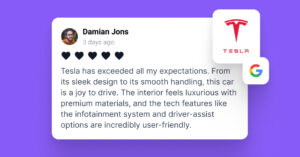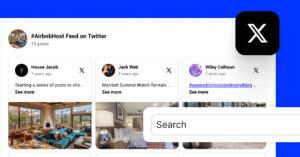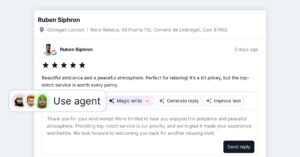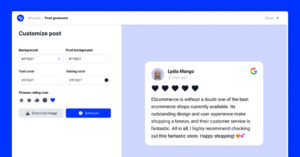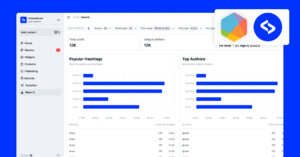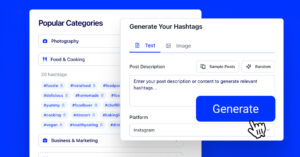Contenu généré par les utilisateurs fait désormais partie intégrante de toute stratégie de marketing.
Alors que les marques s'intéressent de plus en plus aux influenceurs et travaillent avec des créateurs de contenu pour toucher et engager leur public, un domaine reste difficile à appréhender : quelle est la bonne façon d'utiliser le contenu créé par les influenceurs ou les créateurs de contenu ?
Lorsqu'une marque collabore avec des influenceurs pour produire une vidéo ou un autre contenu, il est essentiel de savoir comment utiliser le contenu pour générer davantage de ventes ou accroître la notoriété de la marque une fois le contenu créé.
Les spécialistes du marketing se posent souvent des questions sur la réutilisation du contenu généré par les influenceurs sur d'autres canaux. Cet article présente donc 5 façons de réutiliser le contenu généré par les influenceurs et quelques exemples de marques célèbres qui ont mis en œuvre cette stratégie avec succès.
- Qu'est-ce que le CIG ? Signification du contenu généré par les influenceurs
- Comment réutiliser le contenu généré par les influenceurs ?
- Avantages du contenu généré par les influenceurs
- 5 façons de réutiliser le contenu généré par les influenceurs
- Outils pour générer du contenu d'influence
- FAQ sur le contenu généré par les influenceurs
Qu'est-ce que le CIG ? Signification du contenu généré par les influenceurs
Le contenu généré par les influenceurs est un phénomène qui gagne en popularité depuis quelque temps. Les entreprises font appel aux influenceurs des médias sociaux pour promouvoir organiquement leurs produits et services, ce qui leur permet d'obtenir une véritable visibilité auprès du public dont elles ont besoin. Mais qu'est-ce que le contenu généré par les influenceurs et pourquoi devient-il si populaire ?
En bref, on parle de contenu généré par un influenceur lorsqu'un influenceur crée un contenu unique pour votre marque.
Par exemple, il peut s'agir d'un tweet, d'un post Instagram, d'une vidéo YouTube, d'un article de blog ou de tout autre type de contenu adapté aux besoins de votre entreprise et témoignant avec succès de votre marque ou de vos produits et services spécifiques.
De plus, en réutilisant ce contenu sur votre site, vous pouvez toucher davantage de personnes, les impliquer et asseoir votre autorité simultanément.
Comment réutiliser le contenu généré par les influenceurs ?
Réutiliser, réduire, recycler. Vous en avez entendu parler, n'est-ce pas ? La bonne nouvelle, c'est qu'en plus d'aider l'environnement, ces pratiques peuvent donner d'excellents résultats lorsqu'elles sont appliquées au marketing.
La première chose à faire est de trouver un influenceur adapté à votre marque et obtenir un excellent contenu généré par l'influenceur. Toutefois, vous devez vous assurer que le public de l'influenceur correspond également à votre public cible. Plus le nombre d'adeptes de l'influenceur est important, plus le nombre de personnes qui verront votre message et qui, espérons-le, cliqueront pour en savoir plus sur votre produit sera élevé.
Suivant, décider de l'endroit où vous publierez votre contenu. Le publierez-vous sur les médias sociaux, sur votre site web, dans la presse écrite, dans des publicités ou ailleurs ? N'ayez pas peur de réutiliser le contenu de différentes manières et à différents endroits, à condition qu'il soit adapté à la plateforme. Cela permettra de faire circuler ce contenu de qualité et de le faire connaître à un plus grand nombre de personnes au fil du temps.
Enfin, comme pour toute autre stratégie de marketing, mesurer et analyser les résultats pour mesurer le retour sur investissement et trouver des points d'amélioration afin d'atteindre l'objectif de votre stratégie de contenu.
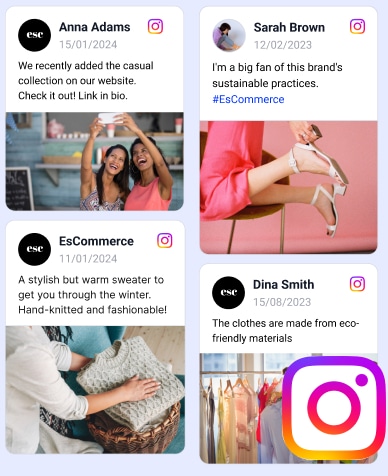
Affichage mur des médias sociaux sur votre site web automatiquement !
Essayez notre Agrégateur de médias sociaux et affichez les flux Instagram, Facebook, YouTube, Pinterest, TikTok et LinkedIn sur votre site web en quelques secondes.
Avantages du contenu généré par les influenceurs
Le monde du marketing de contenu a changé grâce à la relation entre les marques et les influenceurs, et aujourd'hui, le contenu généré par les influenceurs est devenu une nouvelle forme de marketing numérique.
Outre le fait que les influenceurs peuvent influencer les opinions et jouer un rôle déterminant dans le processus de décision d'achat de leur public, de nombreux autres avantages sont autant de bonnes raisons de commencer à réutiliser le contenu généré par les influenceurs à partir de maintenant.
Cela ne coûte pas une fortune et ne prend pas beaucoup de temps
Nombreux sont ceux qui considèrent que le contenu généré par les influenceurs est d'une qualité comparable à celle du contenu produit en studio. De plus, les CIG sont plus diversifiés et plus attrayants que les contenus de studio qui coûteront une fortune à votre entreprise.
De plus, outre le fait qu'elle prend moins de temps, la négociation des droits d'image sur le contenu d'un influenceur est nettement plus rentable qu'une véritable prise de vue en studio professionnel.
Le contenu généré par les influenceurs est très performant
Le contenu généré par les influenceurs provient de personnes qui ont déjà cultivé un public engagé et au moins une certaine confiance dans la marque. Le contenu généré par les influenceurs est donc idéal pour attirer l'attention et accroître l'engagement.
Un contenu authentique et fiable
Dans le marché sursaturé d'aujourd'hui, les marques font beaucoup d'efforts pour être authentiques afin de se démarquer, mais c'est plus facile à dire qu'à faire.
Ainsi, au lieu de consacrer du temps et de l'argent à la recherche de l'authenticité de votre marque, vous pouvez exploiter les possibilités offertes par le contenu généré par les influenceurs et attirer de nouveaux clients grâce à des voix et des points de vue uniques.
En outre, les gens font confiance aux personnes auxquelles ils peuvent s'identifier. Chaque influenceur étant unique à sa manière, collaborer avec plusieurs d'entre eux signifie que vous disposerez d'un contenu diversifié susceptible d'attirer des publics variés intéressés par votre marque.
Un retour sur investissement plus élevé
Le marketing d'influence et le contenu généré par les influenceurs ont l'un des retours sur investissement les plus élevés de tous les canaux de marketing parce qu'ils ne sont pas surpayés. Lorsque vous mettez en œuvre le CIG, vos conversions augmentent tout au long du parcours d'achat.
Même si les coûts sont moindres, les bénéfices seront plus importants si la CIG fait partie de votre processus de création de contenu.
Vous pouvez établir une preuve sociale.
Les influenceurs sont considérés comme des experts dans une niche spécifique. Par conséquent, en travaillant avec des influenceurs qui sont des experts dans votre niche, vous pouvez bénéficier de l'effet d'entraînement de leur réputation sur votre marque.
La réutilisation de ces contenus générés par les influenceurs renforcera cet effet et améliorera la réputation de votre marque.
Il est plus facile de cibler les acheteurs tout au long de l'entonnoir de vente.
Le parcours de l'acheteur comporte trois étapes : la prise de conscience, la réflexion et la décision d'achat. Vous pouvez donc tirer parti de la réutilisation du contenu généré par les influenceurs sur différents canaux et saisir l'occasion de fournir à vos clients potentiels des témoignages authentiques et dignes de confiance tout au long de ce processus.
5 façons de réutiliser le contenu généré par les influenceurs
Une fois que vous avez choisi le meilleur micro-influenceurs Après avoir sélectionné les meilleurs contenus d'influenceurs, voyons ce que vous pouvez faire. Voici les 5 meilleures façons de réutiliser le contenu des influenceurs dans le cadre de vos efforts marketing.
Une chose qui s'applique à tous est de se rappeler de ne pas rediffuser le même contenu sur différents canaux. Pensez plutôt à utiliser le contenu écrit et le contenu visuel différemment sur un autre canal.
Utiliser le contenu généré par les influenceurs dans les publicités
La réutilisation de contenus de qualité générés par des influenceurs à des fins publicitaires est une mine d'or pour tout spécialiste du marketing. En utilisant le CIG pour vos visuels publicitaires, vous attirez des personnes qui sont plus susceptibles de se convertir puisque vous gagnez leur confiance grâce à un contenu authentique.
Pour être plus précis, selon Salesforce, les publicités qui présentent des IGC ou des UGC ont un CTR 5 fois plus élevé que les annonces dont le contenu est moins authentique.
Commencez par vous fixer un objectif précis
Que votre objectif soit d'augmenter le trafic sur votre site web, d'accroître vos ventes ou d'augmenter le nombre de vos abonnés, vous devez avant tout définir votre objectif.
Dans la plupart des cas, les marques commencent par fixer un objectif mesurable qui déterminera le rythme de la collaboration future. Cet objectif peut être simple : obtenir de nouveaux adeptes grâce à la collaboration ou augmenter les ventes grâce au code de réduction utilisé par l'influenceur dans le cadre de la campagne.
Ensuite, choisissez le contenu proprement dit
L'étape suivante, probablement la plus importante, consiste à choisir les éléments de contenu que vous souhaitez promouvoir et la manière dont vous les réutiliserez. Les possibilités sont infinies. Faites donc des recherches pour déterminer quels sont les meilleurs messages pour atteindre votre objectif et réfléchissez au format de la vidéo ou de l'image que vous utiliserez dans l'annonce finale. Il peut s'avérer nécessaire d'apporter quelques modifications, alors assurez-vous d'avoir les ressources et les compétences nécessaires pour le faire.
Choisir les bons canaux de médias sociaux
En marketing, le monde tourne toujours autour de votre public cible. C'est pourquoi, pour que votre stratégie publicitaire soit couronnée de succès, vous devez savoir quels sont les canaux les plus utilisés par votre public actuel et futur. Savoir où ils passent le plus de temps et où ils s'engagent le plus joue un rôle important dans cette stratégie.
Gisou est un excellent exemple de marque qui exploite les possibilités offertes par le contenu des CIG.
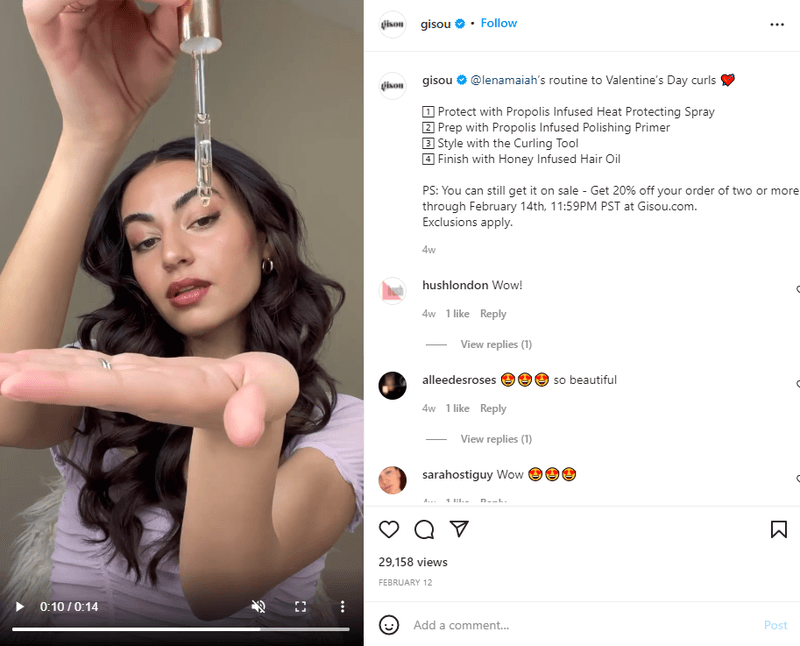
En publiant une vidéo d'une influenceuse utilisant leur produit et montrant qu'elle est satisfaite du résultat final, ils donnent à leurs followers un aperçu des avantages du produit et les encouragent à l'acheter.
En outre, avant de placer votre annonce, il existe une tactique qui change la donne et que vous devez mettre en œuvre pour obtenir des résultats époustouflants.
La pratique la plus efficace pour tirer le meilleur parti des publicités sur le contenu généré par les influenceurs consiste à mettre en place une liste blanche d'influenceurs.
La liste blanche des influenceurs est utilisée lorsque les marques diffusent des publicités payantes sur les médias sociaux, mais qu'au lieu de provenir du compte de la marque, elles proviennent du compte et de l'identité de l'influenceur.
Ainsi, les marques peuvent programmer, financer et suivre les publicités comme d'habitude, mais la publicité sera affichée comme le contenu publié à partir du profil de l'influenceur.
C'est toujours la marque qui rédige le texte et choisit le contenu, mais au lieu de diffuser des publicités disant "achetez nos produits" ou "utilisez nos services", les marques peuvent réaliser des ventes en ayant des annonces de témoignages dignes de confiance avec un bouton d'appel à l'action clair.
De plus, cette méthode est excellente pour les marques qui souhaitent pimenter leur stratégie publicitaire afin de cibler et de convertir plus efficacement de nouveaux publics.
Utiliser le contenu généré par les influenceurs sur le site web
Les témoignages et les avis comptent parmi les formes de recommandation les plus solides pour chaque marque. En outre, les avis émanant d'influenceurs qui jouissent déjà de la confiance d'un public spécifique sont une recommandation que vous devez promouvoir sur votre site web.
L'utilisation de contenu généré par des influenceurs sur votre site web renforcera votre crédibilité et gagnera la confiance de votre public ; c'est pourquoi nous allons vous donner quelques conseils pour vous aider à présenter ce type de contenu avec succès.
Supposons que vous ayez du contenu généré par plusieurs influenceurs. Dans ce cas, vous pouvez créer une section distincte du site web où vous présenterez l'expérience des influenceurs avec votre produit ou vos services. Vous pouvez publier le CIG sous forme de vidéos ou de commentaires et citations textuels.
Marucci est un excellent exemple de marque utilisant du contenu généré par des influenceurs sur un site web. Elle utilise un témoignage de Francisco Lindor et sa photo, ainsi qu'un CTA "Voir plus" qui redirige les utilisateurs vers d'autres témoignages d'influenceurs en rapport avec leur marque.
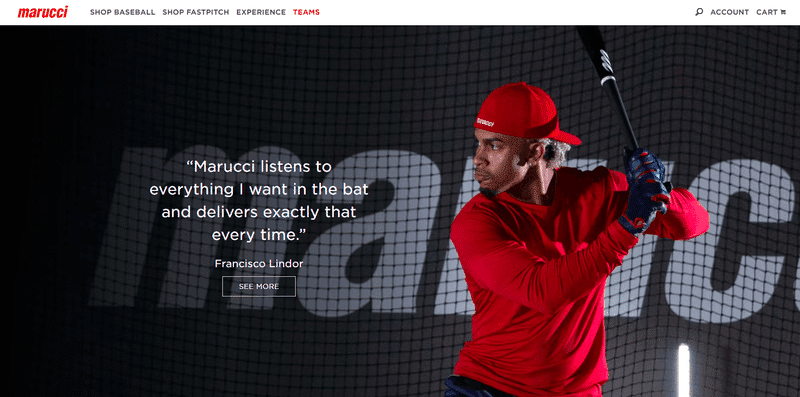
Utiliser le contenu généré par les influenceurs dans les médias imprimés
Le contenu généré par les influenceurs convient également parfaitement à la presse écrite. Les magazines et les journaux ont plus que jamais besoin d'un contenu authentique, car les visuels qu'ils utilisent semblent souvent mis en scène et il est difficile pour les lecteurs de s'y identifier.
D'autre part, l'utilisation du contenu des influenceurs pour faire de la publicité dans les publireportages imprimés augmente la crédibilité. L'ajout de témoignages d'influenceurs de confiance n'est qu'une tactique supplémentaire qui redressera votre stratégie.
Utiliser le contenu généré par les influenceurs dans les lettres d'information et les courriels des clients
Le marketing par courriel est soit sous-estimé, soit les spécialistes du marketing qui en connaissent la valeur ont du mal à inciter les gens à cliquer sur leurs campagnes de courriels. Heureusement, pour ceux qui souhaitent tirer parti des possibilités offertes par le marketing par courriel, l'utilisation de contenu généré par des influenceurs est un moyen éprouvé de créer une campagne de courriels attrayante.
Vous pouvez intégrer le contenu généré par les influenceurs dans les lettres d'information et les courriels des clients en utilisant simplement les noms, les visages et les histoires réels, ainsi que les témoignages des influenceurs. Ainsi, le contenu de votre courriel sera plus convaincant et attirera davantage l'attention que les courriels traditionnels.
De plus, si vous disposez d'une liste de diffusion segmentée, vous pouvez cibler les clients avec des influenceurs qui correspondent à leur style et à leurs normes. Vous pouvez donc pimenter votre stratégie d'envoi d'e-mails avec la preuve sociale ultime que constitue le contenu généré par les influenceurs.
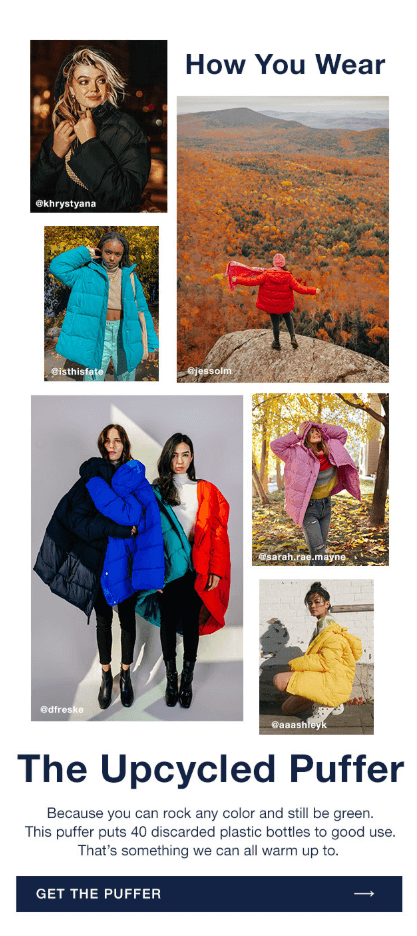
GAP est l'une des nombreuses marques qui utilisent le contenu généré par les influenceurs dans le cadre de leur campagne d'emailing. Comme il s'agit d'une marque de mode, il suffit de poster des photos d'influenceurs coiffant leurs produits. Il n'est pas nécessaire d'ajouter des témoignages ou des avis d'influenceurs. Elles donnent aux gens précisément ce dont ils ont besoin - une idée de la façon de styliser les produits GAP.
Signalisation extérieure
Même si l'époque des panneaux d'affichage et des enseignes de vitrine semble définitivement révolue, lorsqu'ils sont utilisés correctement, ils restent l'une des stratégies de marketing les plus efficaces.
Comme pour les tactiques mentionnées ci-dessus, l'utilisation du contenu généré par les influenceurs dans la signalisation extérieure, les promotions en magasin et d'autres supports hors ligne permet à un plus grand nombre de clients de s'identifier à votre contenu de marque à chaque point de contact.
Un bon exemple de marque dotée d'une solide stratégie de marketing hors ligne est le suivant Glossier. Même si vous n'êtes pas un fan de maquillage, il n'y a aucune chance que vous n'en ayez pas entendu parler. Et c'est le cas, grâce à la forte présence de la marque en ligne et hors ligne.
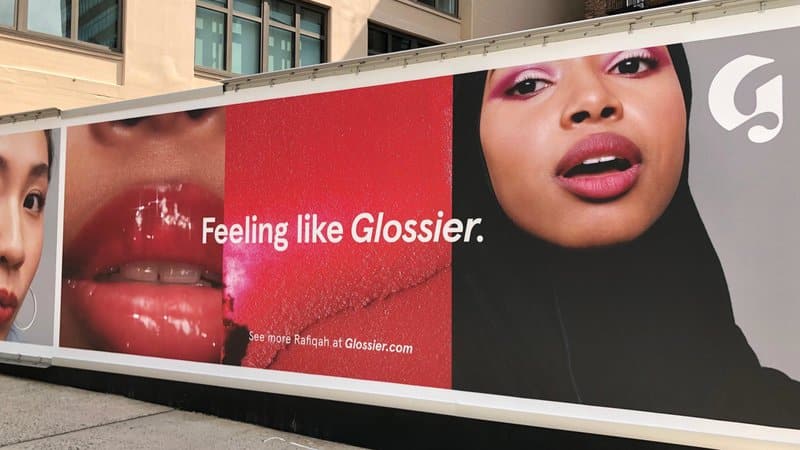
En réutilisant le contenu exact qu'elle partage sur son Instagram et son site web sur des panneaux d'affichage à travers le pays, cette marque se connecte avec son public en ligne dans la vie réelle.
Ils savent que le fait de présenter des influenceurs, des gourous de la beauté et de vrais clients plutôt que des top-modèles hautement photoshoppés sur les panneaux d'affichage trouvera un écho auprès d'un public plus large.
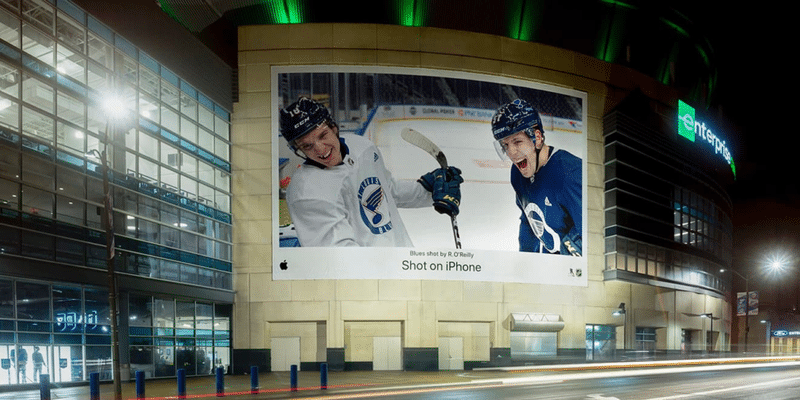
En parlant de façons innovantes d'utiliser le contenu généré par les influenceurs, nous ne pouvons pas passer sous silence ce panneau d'affichage super cool d'Apple. Le panneau d'affichage de l'image ci-dessus fait partie de la campagne d'Apple "Shot on iPhone Challenge" qui avait pour but de mettre en valeur les fonctionnalités des appareils photo de l'iPhone en montrant des images prises par des photographes à l'aide de leurs téléphones.
Elle s'est associée à la Ligue nationale de hockey pour présenter les images brutes et organiques que les joueurs préférés des supporters (influenceurs) prennent avec leur téléphone.
Ce partenariat a réuni les expériences hors domicile et numériques en réalisant une campagne simultanée de stories Instagram qui a donné aux fans de hockey un contenu de style "jour dans la vie" mettant en scène leurs joueurs préférés.
Outils pour générer du contenu d'influence
Deux options s'offrent à vous lorsqu'il s'agit de générer des contacts avec des influenceurs. La première consiste à établir vous-même une relation avec les influenceurs, et la seconde à utiliser une plateforme ou une agence pour le faire afin de vous consacrer à votre travail principal.
Si vous décidez de le faire vous-même, suivez une méthode qui a fait ses preuves. guide pour trouver des influenceurs sur chaque plateforme pour trouver rapidement des influenceurs dans votre niche.
Toutefois, si vous choisissez de vous faire aider, cinq outils sont excellents pour générer du contenu d'influence.
Upfluence
Upfluence est une plateforme d'influence à part entière qui vous aide à tirer le meilleur parti de vos campagnes, de la recherche à la sensibilisation. Avec une base de données massive de plus de 3 millions de profils d'influenceurs, cet outil offre un ensemble complet de fonctionnalités visant à vous aider à créer du contenu, à rechercher des influenceurs et à vous engager directement auprès d'eux pour générer davantage de notoriété de marque et de pistes de vente.
Aspirer
Aspirer est une plateforme marketing d'intelligence communautaire conçue pour l'advocacy. Elle considère votre communauté comme les meilleurs influenceurs de tous les clients, créatifs, professionnels, experts, employés et représentants de marques qui partagent les mêmes valeurs et la même passion liées à votre marque au-delà du produit ou du service que vous vendez.
EmbedSocial
EmbedSocial a développé EmbedFeed - une plateforme innovante qui vous permet d'intégrer des flux Instagram, YouTube et Twitter sur votre site web, votre blog ou l'URL d'une campagne spécifique.
L'agrégateur peut être utilisé pour créer des murs de hashtags interactifs et attrayants où les clients peuvent voir toutes les preuves sociales de votre marque en un seul endroit. Il offre également des options de personnalisation qui garantissent que chaque mur de hashtags est unique et conforme au ton général de la marque communiqué sur le site web.
Influence.co
Influence.co est une place de marché pour influenceurs, mais elle fonctionne également comme un réseau social permettant aux marques et aux influenceurs de se trouver et de se connecter les uns aux autres. À ce jour, Influence.co compte près de 250 000 membres, dont plus de 140 000 influenceurs, 60 000 marques et 30 000 autres utilisateurs qui ne sont ni l'un ni l'autre.
Hunter.io
Hunter.io est un outil puissant pour la recherche d'adresses électroniques, et il est utile aux spécialistes du marketing qui cherchent à contacter des personnes influentes. Entrez un nom et un domaine dans Hunter.io, et vous trouverez l'adresse électronique de toute personne travaillant dans cette entreprise, ainsi que des détails tels que les profils sociaux et la structure de l'entreprise.
FAQ sur le contenu généré par les influenceurs
Jusqu'à présent, vous avez franchi toutes les étapes de la mise en place d'une stratégie de marketing des CIG. Toutefois, si certaines parties du processus vous laissent encore perplexe, voici quelques questions fréquemment posées qui pourraient vous intéresser.
Contrairement à l'UGC, où les utilisateurs quotidiens de la marque en parlent eux-mêmes sur les médias sociaux à leurs amis, parents et collègues, pour générer du contenu généré par les influenceurs, les marques doivent découvrir des influenceurs dont les intérêts, les valeurs et les publics correspondent à ceux de la marque pour promouvoir leurs produits et services.
Le prix de la collaboration avec les influenceurs varie en fonction du nombre de followers, du type de message et de la plateforme de médias sociaux. Par exemple, les nano-influenceurs ayant moins de 10 000 followers facturent entre $10 et $200 par message, et les micro-influenceurs (ceux qui ont entre 10 000 et 50 000 followers) peuvent facturer jusqu'à $1000 par message.
Avant de partager le contenu d'un influenceur sur le compte de votre marque, vous devez toujours demander la permission. Le partage de contenu sur les médias sociaux est gratuit, mais vous devez citer le créateur et fournir un lien vers son profil. Toutefois, les droits d'image peuvent également être achetés auprès du créateur et partagés n'importe où sans citation.

Affichage mur des médias sociaux sur votre site web automatiquement !
Essayez notre Agrégateur de médias sociaux et affichez les flux Instagram, Facebook, YouTube, Pinterest, TikTok et LinkedIn sur votre site web en quelques secondes.

